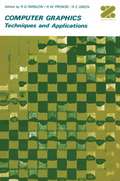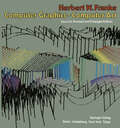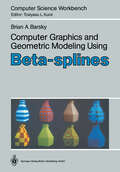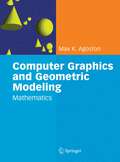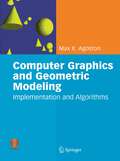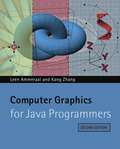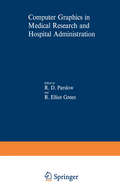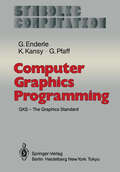- Table View
- List View
Computer Graphics: Techniques and Applications
by Robert D. ParslowAbout four or five years ago one began to hear about the enormous interest being taken in on-line consoles and displays. Nothing much was done with them, but computer men felt that this was the way computing ought to go: one might dispense with cards, and overcome many of the problems of man-machine communication. It quickly appeared that, as with computers, there had been a great under estimation of the amount of work involved, of the difficulties of programming, and of the cost. So it began to emerge that graphics was not the ultimate answer, in spite of superb demonstrations where one might watch a square being converted into a cube and then rotated. But my mind goes back to 1951 and the first computers. There, there were demonstrations of arithmetic speed and storage facility; but not much idea of actual use. However, we now understand how to use computers, and in the last year or two, significant developments in the field of graphics have led to genuine applications, and economic benefits. The equipment is still expensive, but it is becoming cheaper, more uses are being found, and f believe that we are just at the stage when the subject is gaining momentum, to become, like computers, a field of immense importance.
Computer Graphics — Computer Art
by Herbert W. FrankeTen years have passed since the first edition of this book, a time sary to stress that the availability of colors further assists artistic span during which all activities connected with computers have ambitions. experienced an enormous upswing, due in particular to the ad The dynamics of display which can be achieved on the screen is vances in the field of semiconductor electronics which facilitated also of significance for the visual arts. It is a necessary condition microminiaturization. With the circuit elements becoming small for some technical applications, for example when simulating er and smaller, i. e. the transition to integrated circuits, the price dynamic processes. Although the graphics systems operating in real time were not designed for artistic purposes, they nonethe of hardware was reduced to an amazingly low level: this has de less open the most exciting aspects to the visual arts. While the finitely been an impulse of great importance to the expansion of computer technology, as well as to areas far removed from tech static computer picture was still a realization in line with the nology.
Computer Graphics 1987: Proceedings of CG International ’87
by Tosiyasu L. KuniiRecent developments in computer graphics have largely involved the following: Integration of computer graphics and image analysis through computer data structure; integration of CAD/CAM as computer-integrated manufacturing (CIM) through the design and simulation of manufacturing processes using computer graphics; progress in basic research on the modeling of complex and mathematical graphic objects, such as computational geometry, graphic data bases, hierarchical windows, and texture; use of computer graphics as an improved human interface to present information visually and multidimensionally; and advancement of industrial technology and computer art based on developments in the areas listed above. These trends are strongly reflected in the contents of the present volume either as papers dealing with one particular aspect of research or as multifaceted studies involving several different areas. The proceedings comprise thirty selected, previously unpublished original papers presented in nine chapters.
Computer Graphics and CAD
by C.S. Verma Rajesh Purohit Koyel Datta Gupta Harsha VermaThis book discusses the fundamental concepts shaping modern design and visualization definition through Computer Graphics and the intricacies of CAD modelling practices.From 3D object representation to surface modelling and solid techniques, subsequent chapters offer a comprehensive exploration of advanced topics essential for geometric modelling. With a focus on industry applications and practical examples, readers acquire the skills needed to navigate the complexities of animation systems and finite element analysis, ensuring a holistic understanding of CAD and Computer Graphics. Whether you're a novice or seasoned professional, this guide provides a rich blend of theory and practice, accompanied by a wealth of solved and unsolved problems for hands-on learning.Print edition not for sale in South Asia (India, Sri Lanka, Nepal, Bangladesh, Pakistan or Bhutan)
Computer Graphics and CAD
by C.S. Verma Rajesh Purohit Koyel Datta Gupta Harsha VermaThis book discusses the fundamental concepts shaping modern design and visualization definition through Computer Graphics and the intricacies of CAD modelling practices.From 3D object representation to surface modelling and solid techniques, subsequent chapters offer a comprehensive exploration of advanced topics essential for geometric modelling. With a focus on industry applications and practical examples, readers acquire the skills needed to navigate the complexities of animation systems and finite element analysis, ensuring a holistic understanding of CAD and Computer Graphics. Whether you're a novice or seasoned professional, this guide provides a rich blend of theory and practice, accompanied by a wealth of solved and unsolved problems for hands-on learning.Print edition not for sale in South Asia (India, Sri Lanka, Nepal, Bangladesh, Pakistan or Bhutan)
Computer Graphics and Geometric Modeling
by David SalomonA book for those interested in how modern graphics programs work and how they can generate realistic-looking objects. It emphasises the mathematics behind computer graphics, most of which is included in an appendix. The main topics covered are: scan conversion methods; selecting the best pixels for generating lines, circles and other objects; geometric transformations and projections; translations, rotations, moving in 3D, perspective projections, curves and surfaces; construction, wire-frames, rendering, normals; CRTs, antialiasing, animation, colour, perception, polygons, compression. With its numerous illustrative examples and exercises, the book is ideal for a two-semester course for advanced undergraduates or graduates, while also making a fine reference for professionals in the field.
Computer Graphics and Geometric Modeling Using Beta-splines (Computer Science Workbench)
by Brian A. BarskyComputer Graphics and Geometric Modelling: Mathematics
by Max K. AgostonPossibly the most comprehensive overview of computer graphics as seen in the context of geometric modelling, this two volume work covers implementation and theory in a thorough and systematic fashion. Computer Graphics and Geometric Modelling: Mathematics, contains the mathematical background needed for the geometric modeling topics in computer graphics covered in the first volume. This volume begins with material from linear algebra and a discussion of the transformations in affine & projective geometry, followed by topics from advanced calculus & chapters on general topology, combinatorial topology, algebraic topology, differential topology, differential geometry, and finally algebraic geometry. Two important goals throughout were to explain the material thoroughly, and to make it self-contained. This volume by itself would make a good mathematics reference book, in particular for practitioners in the field of geometric modelling. Due to its broad coverage and emphasis on explanation it could be used as a text for introductory mathematics courses on some of the covered topics, such as topology (general, combinatorial, algebraic, and differential) and geometry (differential & algebraic).
Computer Graphics and Geometric Modelling: Implementation & Algorithms
by Max K. AgostonPossibly the most comprehensive overview of computer graphics as seen in the context of geometric modelling, this two volume work covers implementation and theory in a thorough and systematic fashion. Computer Graphics and Geometric Modelling: Implementation and Algorithms, covers the computer graphics part of the field of geometric modelling and includes all the standard computer graphics topics. The first part deals with basic concepts and algorithms and the main steps involved in displaying photorealistic images on a computer. The second part covers curves and surfaces and a number of more advanced geometric modelling topics including intersection algorithms, distance algorithms, polygonizing curves and surfaces, trimmed surfaces, implicit curves and surfaces, offset curves and surfaces, curvature, geodesics, blending etc. The third part touches on some aspects of computational geometry and a few special topics such as interval analysis and finite element methods. The volume includes two companion programs.
Computer Graphics and Mathematics (Focus on Computer Graphics)
by Bianca Falcidieno Ivan Herman Caterina PienoviSince its very existence as a separate field within computer science, computer graphics had to make extensive use of non-trivial mathematics, for example, projective geometry, solid modelling, and approximation theory. This interplay of mathematics and computer science is exciting, but also makes it difficult for students and researchers to assimilate or maintain a view of the necessary mathematics. The possibilities offered by an interdisciplinary approach are still not fully utilized. This book gives a selection of contributions to a workshop held near Genoa, Italy, in October 1991, where a group of mathematicians and computer scientists gathered to explore ways of extending the cooperation between mathematics and computer graphics.
Computer Graphics for Artists II: Environments and Characters
by Andrew PaquetteIn this second volume of Computer Graphics for Artists the author, Andrew Paquette, guides the reader through the creation of realistic computer-generated backgrounds and characters. Rather than teach using a specific program, the author focuses on the theory required to ensure that the artist can create a convincing landscape, building, person or whatever they turn their attention to. Part One covers the core areas of background generation, such as CG terrain, plant life and architecture, but also deals with specific concepts such as photo-texturing and lighting, explaining all the advantages and pitfalls involved. Part Two introduces the reader to the study of the body-shape and movement and their consequent effects upon successful digital-recreation, as well as addressing some of the fundamental elements of appearance; hair, skin and fat. It is assumed that readers will be familiar with the terms and concepts described in the first volume of this work.
Computer Graphics for Artists: An Introduction
by Andrew PaquettePacked with exercises, this book is an application-independent and reader-friendly primer for anyone with a serious desire to understand 3D Computer Graphics. Opening with the first and most basic elements of computer graphics, the book rapidly advances into progressively more complex concepts. Each of the elements, however simple, are important to understand because each is an essential link in a chain that allows an artist to master any computer graphics application. With this accomplished, the artist can use technology to satisfy his/her goals, instead of the technology being master of the artist.
Computer Graphics for Java Programmers
by Leen Ammeraal Kang ZhangA great many varied and interesting visual effects can be achieved with computer graphics, for which a fundamental understanding of the underlying mathematical concepts – and a knowledge of how they can be implemented in a particular programming language – is essential. Computer Graphics for Java Programmers, 2nd edition covers elementary concepts in creating and manipulating 2D and 3D graphical objects, covering topics from classic graphics algorithms to perspective drawings and hidden-line elimination. Completely revised and updated throughout, the second edition of this highly popular textbook contains a host of ready-to-run-programs and worked examples, illuminating general principles and geometric techniques. Ideal for classroom use or self-study, it provides a perfect foundation for programming computer graphics using Java.
Computer Graphics for Java Programmers
by Leen Ammeraal Kang ZhangThis third edition covers fundamental concepts in creating and manipulating 2D and 3D graphical objects, including topics from classic graphics algorithms to color and shading models. It maintains the style of the two previous editions, teaching each graphics topic in a sequence of concepts, mathematics, algorithms, optimization techniques, and Java coding. Completely revised and updated according to years of classroom teaching, the third edition of this highly popular textbook contains a large number of ready-to-run Java programs and an algorithm animation and demonstration open-source software also in Java. It includes exercises and examples making it ideal for classroom use or self-study, and provides a perfect foundation for programming computer graphics using Java. Undergraduate and graduate students majoring specifically in computer science, computer engineering, electronic engineering, information systems, and related disciplines will use this textbook for their courses. Professionals and industrial practitioners who wish to learn and explore basic computer graphics techniques will also find this book a valuable resource.
Computer Graphics in Medical Research and Hospital Administration
by R. ElliotGreen R. D. ParslowThe graphics terminal makes it possible for people who are not computer specialists to communicate with computers on an inter active basis, without the delay or inconvenience of working constantly through an intermediary. It provides a language of shapes or symbols (full graphics) or words and numbers (alphanumerics) which is understood by both man and machine. The visual output and input facility has considerably widened the applications of computers within the medical world, bringing their enormous powers of data handling and simulation to bear on solving problems in adminis tration, patient monitoring and clinical analysis and research. The purpose of this book is to provide examples of the work being carried out now in the U.K. and U.S.A., showing the applications of all types of installations-from small to very complex-for both administrative and research uses. It gives a brief overview of benefits already derived and of future plans; of hardware utilisation and of software approach; of problems met and of problems solved. The intention is to acquaint executives and researchers in all branches of the medical world with the rapid progress being made in computer graphics and to stimulate thought on which way the technique can be developed to the advantage of all.
The Computer Graphics Manual (Texts in Computer Science)
by David SalomonThis book presents a broad overview of computer graphics (CG), its history, and the hardware tools it employs. Covering a substantial number of concepts and algorithms, the text describes the techniques, approaches, and algorithms at the core of this field. Emphasis is placed on practical design and implementation, highlighting how graphics software works, and explaining how current CG can generate and display realistic-looking objects. The mathematics is non-rigorous, with the necessary mathematical background introduced in the Appendixes. Features: includes numerous figures, examples and solved exercises; discusses the key 2D and 3D transformations, and the main types of projections; presents an extensive selection of methods, algorithms, and techniques; examines advanced techniques in CG, including the nature and properties of light and color, graphics standards and file formats, and fractals; explores the principles of image compression; describes the important input/output graphics devices.
Computer Graphics Programming: GKS — The Graphics Standard (Symbolic Computation)
by G. Enderle K. Kansy G. PfaffFor several years the authors of this book have been involved in the design and the national and international review of the forthcoming graphical standard. When the end of this process could be foreseen and the International Standard "Graphical Kernel System" (GKS) was cast into its. final form, the urgent need arose for detailed information to the graphics community about this stan dard and for the education of graphics programmers. One major goal of GKS, besides the portability of graphical application programs and the device inde pendence, is "programmer portability" by establishing a common base for train ing of graphics programmers. Having accompanied the path of GKS from the very early stages of defining the basic concepts and designing its first versions up to the final draft of the International Standard, we feIt it worthwhile to start the venture of a text book on computer graphics programming based on GKS. This book is aimed, at one hand, at graphics users, experts and managers who want to get an overview of the new standard and a better understanding of its concepts. On the other hand, it addresses the graphics programmers who want to use GKS for realizing their graphical applications. It can serve as the base for teaching and studying functions, concepts and methods of GKS. Addi tionally, it will be a valuable source of information for implementors of GKS.
Computer Graphics Programming: GKS — The Graphics Standard (Symbolic Computation)
by Günter Enderle Klaus Kansy Günther PfaffTO COMPUTER GRAPHICS BASED ONGKS Part I gives an introduction to basic concepts of computer graph ics and to the principles and concepts of GKS. The aims of this part are twofold: to provide the beginner with an overview of the terminology and concepts of computer graphics, based on GKS, and to give the computer graphics expert an introduc tion to the GKS standard. In the early chapters of this part, the main areas of computer graphics, the various classes of com puter graphics users, the interfaces of GKS and its underlying design concepts are discussed and important terms are defined. The later chapters give an informal introduction to the main concepts of GKS and their interrelationships: output, attributes, coordinate systems, transformations, input, segments, metafile, state lists, and error handling. This introduction to the GKS framework will prepare the ground for the detailed description of 2D GKS functions in Part III and the 3D extensions to GKS in Part IV. 1 WHAT IS COMPUTER GRAPHICS? 1. 1 Defmition of Computer Graphics The Data Processing Vocabulary of the International Organization for Stan dardization (ISO) [ISO 84] defines Computer Graphics as follows: "Methods and techniques for converting data to and from a graphic display via computer. " This definition refers to three basic components of any computer graphics system - namely "data", "computer", and "display".
Computer Graphics through Key Mathematics
by Huw JonesThis book introduces the mathematical concepts that underpin computer graphics. It is written in an approachable way, without burdening readers with the skills of ow to do'things. The author discusses those aspects of mathematics that relate to the computer synthesis of images, and so gives users a better understanding of the limitations of computer graphics systems. Users of computer graphics who have no formal training and wish to understand the essential foundations of computer graphics systems will find this book very useful, as will mathematicians who want to understand how their subject is used in computer image synthesis. '
Computer Graphics Through OpenGL: From Theory to Experiments
by Sumanta GuhaFrom geometric primitives to animation to 3D modeling to lighting, shading, and texturing, Computer Graphics Through OpenGL: From Theory to Experiments, Second Edition presents a comprehensive introduction to computer graphics that uses an active learning style to teach key concepts. Equally emphasizing theory and practice, the book provides an und
Computer Graphics Through OpenGL®: From Theory to Experiments
by Sumanta GuhaCOMPREHENSIVE COVERAGE OF SHADERS AND THE PROGRAMMABLE PIPELINE From geometric primitives to animation to 3D modeling to lighting, shading and texturing, Computer Graphics Through OpenGL®: From Theory to Experiments is a comprehensive introduction to computer graphics which uses an active learning style to teach key concepts. Equally emphasizing theory and practice, the book provides an understanding not only of the principles of 3D computer graphics, but also the use of the OpenGL® Application Programming Interface (API) to code 3D scenes and animation, including games and movies. The undergraduate core of the book takes the student from zero knowledge of computer graphics to a mastery of the fundamental concepts with the ability to code applications using fourth-generation OpenGL®. The remaining chapters explore more advanced topics, including the structure of curves and surfaces, applications of projective spaces and transformations and the implementation of graphics pipelines. This book can be used for introductory undergraduate computer graphics courses over one to two semesters. The careful exposition style attempting to explain each concept in the simplest terms possible should appeal to the self-study student as well. Features • Covers the foundations of 3D computer graphics, including animation, visual techniques and 3D modeling• Comprehensive coverage of OpenGL® 4.x, including the GLSL and vertex, fragment, tessellation and geometry shaders• Includes 180 programs with 270 experiments based on them• Contains 750 exercises, 110 worked examples, and 700 four-color illustrations• Requires no previous knowledge of computer graphics• Balances theory with programming practice using a hands-on interactive approach to explain the underlying concepts
Computer Graphics Through OpenGL®: From Theory to Experiments
by Sumanta GuhaCOMPREHENSIVE COVERAGE OF SHADERS AND THE PROGRAMMABLE PIPELINE From geometric primitives to animation to 3D modeling to lighting, shading and texturing, Computer Graphics Through OpenGL®: From Theory to Experiments is a comprehensive introduction to computer graphics which uses an active learning style to teach key concepts. Equally emphasizing theory and practice, the book provides an understanding not only of the principles of 3D computer graphics, but also the use of the OpenGL® Application Programming Interface (API) to code 3D scenes and animation, including games and movies. The undergraduate core of the book takes the student from zero knowledge of computer graphics to a mastery of the fundamental concepts with the ability to code applications using fourth-generation OpenGL®. The remaining chapters explore more advanced topics, including the structure of curves and surfaces, applications of projective spaces and transformations and the implementation of graphics pipelines. This book can be used for introductory undergraduate computer graphics courses over one to two semesters. The careful exposition style attempting to explain each concept in the simplest terms possible should appeal to the self-study student as well. Features • Covers the foundations of 3D computer graphics, including animation, visual techniques and 3D modeling• Comprehensive coverage of OpenGL® 4.x, including the GLSL and vertex, fragment, tessellation and geometry shaders• Includes 180 programs with 270 experiments based on them• Contains 750 exercises, 110 worked examples, and 700 four-color illustrations• Requires no previous knowledge of computer graphics• Balances theory with programming practice using a hands-on interactive approach to explain the underlying concepts
Computer Graphics Through OpenGL®: From Theory to Experiments
by Sumanta GuhaCOMPREHENSIVE COVERAGE OF SHADERS, THE PROGRAMMABLE PIPELINE AND WEBGL From geometric primitives to animation to 3D modeling to lighting, shading and texturing, Computer Graphics Through OpenGL®: From Theory to Experiments is a comprehensive introduction to computer graphics which uses an active learning style to teach key concepts. Equally emphasizing theory and practice, the book provides an understanding not only of the principles of 3D computer graphics, but also the use of the OpenGL® Application Programming Interface (API) to code 3D scenes and animation, including games and movies. The undergraduate core of the book takes the student from zero knowledge of computer graphics to a mastery of the fundamental concepts with the ability to code applications using fourth-generation OpenGL®, as well as using WebGL® in order to publish to the web. The remaining chapters explore more advanced topics, including the structure of curves and surfaces, applications of projective spaces and transformations and the implementation of graphics pipelines. This book can be used for introductory undergraduate computer graphics courses over one to two semesters. The careful exposition style attempting to explain each concept in the simplest terms possible should appeal to the self-study student as well. Features Covers the foundations of 3D computer graphics, including animation, visual techniques and 3D modeling Comprehensive coverage of OpenGL® 4.x, including the GLSL and vertex, fragment, tessellation and geometry shaders Comprehensive coverage of WebGL® 2.0. Includes 440 programs and experiments Contains 700 exercises, 100 worked examples and 650 four-color illustrations Requires no previous knowledge of computer graphics Balances theory with programming practice using a hands-on interactive approach to explain the underlying concepts
Computer Graphics Through OpenGL®: From Theory to Experiments
by Sumanta GuhaCOMPREHENSIVE COVERAGE OF SHADERS, THE PROGRAMMABLE PIPELINE AND WEBGL From geometric primitives to animation to 3D modeling to lighting, shading and texturing, Computer Graphics Through OpenGL®: From Theory to Experiments is a comprehensive introduction to computer graphics which uses an active learning style to teach key concepts. Equally emphasizing theory and practice, the book provides an understanding not only of the principles of 3D computer graphics, but also the use of the OpenGL® Application Programming Interface (API) to code 3D scenes and animation, including games and movies. The undergraduate core of the book takes the student from zero knowledge of computer graphics to a mastery of the fundamental concepts with the ability to code applications using fourth-generation OpenGL®, as well as using WebGL® in order to publish to the web. The remaining chapters explore more advanced topics, including the structure of curves and surfaces, applications of projective spaces and transformations and the implementation of graphics pipelines. This book can be used for introductory undergraduate computer graphics courses over one to two semesters. The careful exposition style attempting to explain each concept in the simplest terms possible should appeal to the self-study student as well. Features Covers the foundations of 3D computer graphics, including animation, visual techniques and 3D modeling Comprehensive coverage of OpenGL® 4.x, including the GLSL and vertex, fragment, tessellation and geometry shaders Comprehensive coverage of WebGL® 2.0. Includes 440 programs and experiments Contains 700 exercises, 100 worked examples and 650 four-color illustrations Requires no previous knowledge of computer graphics Balances theory with programming practice using a hands-on interactive approach to explain the underlying concepts
Computer Graphics with Open GL: Pearson New International Edition
by Donald Hearn Pauline Baker Warren CarithersFor junior- to graduate-level courses in computer graphics. Assuming no background in computer graphics, this junior- to graduate-level textbook presents basic principles for the design, use, and understanding of computer graphics systems and applications. The authors, authorities in their field, offer an integrated approach to two-dimensional and three-dimensional graphics topics. A comprehensive explanation of the popular OpenGL programming package, along with C++ programming examples illustrates applications of the various functions in the OpenGL basic library and the related GLU and GLUT packages. The full text downloaded to your computer With eBooks you can: search for key concepts, words and phrases make highlights and notes as you study share your notes with friends eBooks are downloaded to your computer and accessible either offline through the Bookshelf (available as a free download), available online and also via the iPad and Android apps. Upon purchase, you'll gain instant access to this eBook. Time limit The eBooks products do not have an expiry date. You will continue to access your digital ebook products whilst you have your Bookshelf installed.
